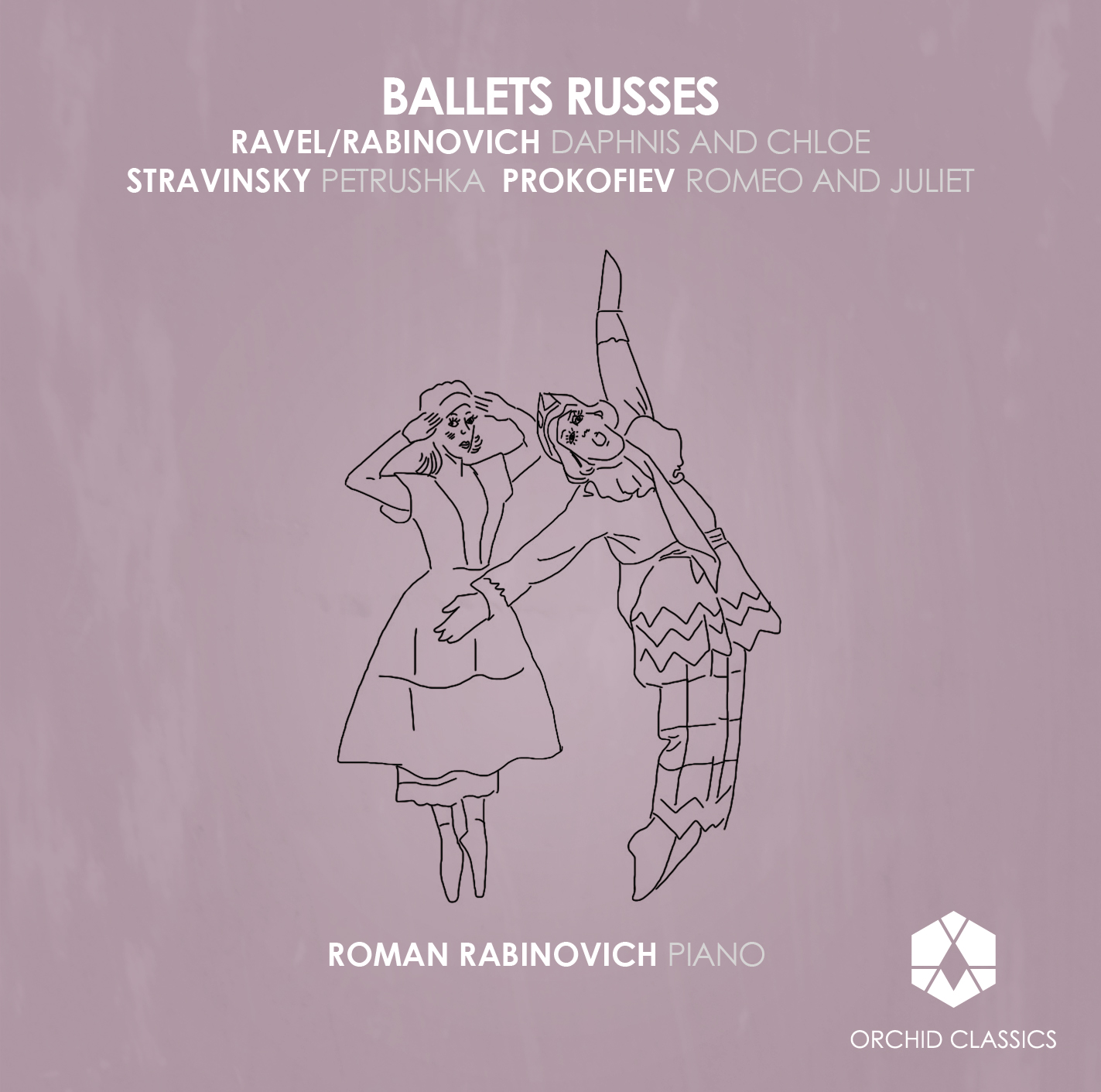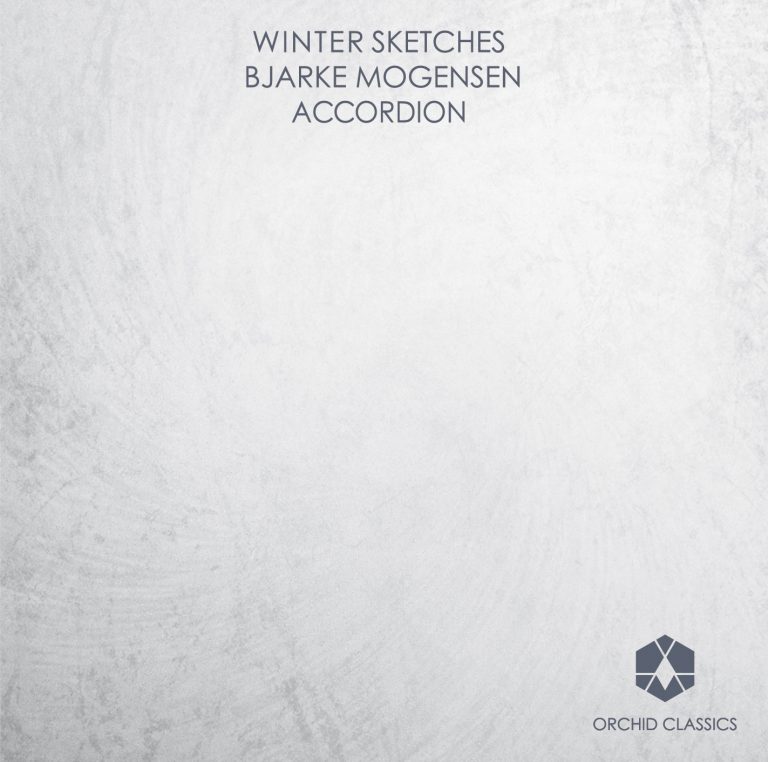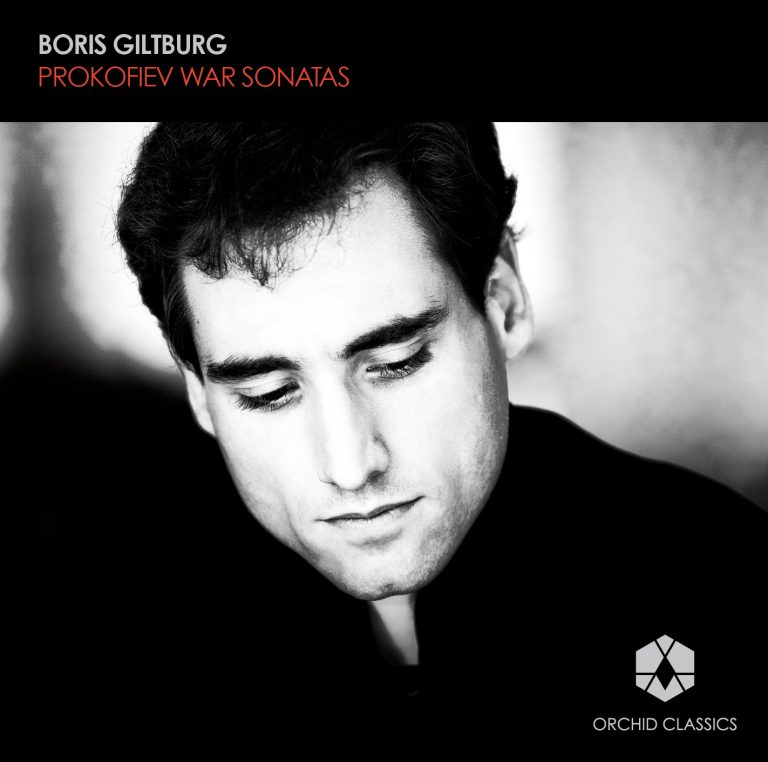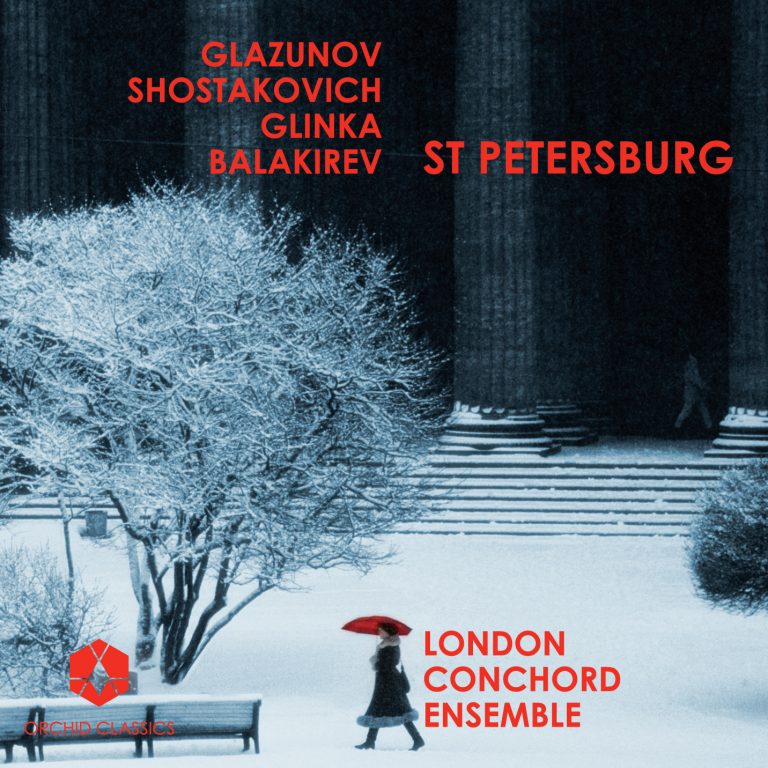Artist Led, Creatively Driven

Ballets Russes
Roman Rabinovich
Release Date: March 2013
ORC100028
SERGEI PROKOFIEV (1891-1953)
Romeo and Juliet: Ten Pieces for Piano, Op.75
Folk Dance
Scene: The Street Awakens
Minuet: Arrival of the Guests
Juliet as a Young Girl
Masquers
Montagues and Capulets
Friar Laurence
Mercutio
Dance of the Girls with Lilies
Romeo and Juliet before Parting
MAURICE RAVEL (1875-1937) arranged by ROMAN RABINOVICH
Two movements from Daphnis and Chloe
Pantomime
Danse générale
IGOR STRAVINSKY (1882-1971)
Three Movements from Petrushka
Danse russe (Russian Dance)
Chez Petrouchka (Petrushka’s Room)
La semaine grasse (The Shrovetide Fair; Mardi Gras)
BALLETS RUSSES
This recording is my homage to an exciting era. I first came to learn about the Ballets Russes and Sergei Diaghilev as a young teenager, through my interest in Leon Bakst, a wonderful Russian artist, mostly remembered now for his designs for Daphnis and Chloe, Sheherezade and many other famous Diaghilev productions. Reading about this era of incredible artistic happenings in early 20th century Paris, I learned that the Ballets Russes had a profound influence on the artistic trends of the next few generations. The company’s grand- scale productions, which spanned its first season in 1907, through to Diaghilev’s death in 1929 and later became known as Ballet Russe de Monte Carlo until the 1950s, instantly became one of the most prestigious attractions in the Western world. These productions fused avant- garde music, dance and style in a fresh and innovative way that was forward- looking and radical. Diaghilev’s stars were Nijinsky, Pavlova, Massine, Picasso, Matisse…and Stravinsky, Ravel and Prokofiev.
The three pieces I perform on this recording are arrangements. While preparing them I was faced with an obvious problem: how can I play this music on the piano without compromising the luscious and colourful timbres of the orchestration? Stravinsky, Prokofiev and Ravel were among the greatest masters of orchestration in music history and playing their scores on “merely” a piano might seem to some as a limitation. I believe that the solution to this problem lies within the nature of the piano, which is a self-sufficient, self-contained instrument. Its notes range higher and lower than the entire orchestra, and it can produce a wide variety of dynamic colours and effects. I feel that one can play anything on the piano. Therefore, these arrangements are not direct transcriptions. They are not meant merely to reproduce the sounds of the orchestra but instead they stand in their own right as essentially pianistic pieces that are derived from the original ballets.
Fortunately, both Stravinsky and Prokofiev wrote their own brilliant piano arrangements. Stravinsky arranged the Three movements from Petrushka for Arthur Rubinstein and Prokofiev premiered the Ten Pieces from Romeo and Juliet, Op.75 himself. As for Ravel’s Daphnis, I discovered Ravel made a piano reduction of the entire ballet for rehearsal purposes. It was, however, never intended for a concert performance; the writing is too bare and feels “unfinished” to me. This reduction became the starting point of my arrangement, and despite my initial fears, I feel that Daphnis fits the piano extremely well. This passionate masterpiece, based on the Greek tale by Longus, is full of seductive harmonies and rich textures. It is poetic and overwhelmingly sensual. I chose the last two movements, where Daphnis and Chloe are miming the tale of the gods, Pan and Syrinx. In order to seduce Chloe, Daphnis plays a gorgeous tune on the flute, while Chloe dances to it. The dance becomes more and more animated and finally they fall into each other’s arms. They declare their love for each other, and the piece concludes with an ecstatic Danse générale. Daphnis was premiered by the Ballets Russes in 1912, only one year after Petrushka.
Listening to the recording of Petrushka when I was growing up, I was taken by its bold expression and extreme theatricality, and of course, its sheer excitement was compelling to my young sensibilities. I instantly fell in love with the piece. The Russian Dance is a scene where the three puppets – Petrushka, Ballerina and a Moor – come to life after the Charlatan’s magic spell and they dance together. The next movement – Petrushka’s Room – is the emotional core of the suite, with Petrushka anxious and unhappy in his cell, being “imprisoned” by the Charlatan and falling in love with the Ballerina, who rejects him. Petrushka is in despair. The last movement – The Shrovetide Fair; Mardi Gras – is a group of dances with Russian tunes. It ends with a fight between Petrushka and the Moor over the Ballerina, and eventually leads to Petrushka’s death. However, since he is merely a puppet, is any of this real?
The score is a collage of Russian folk-like tunes, with extended harmonies, polyrhythms and complex metres. Playing Petrushka on the piano is a big technical challenge. The writing is quite unusual in its rapid jumps, thick chords and fast tremolos. It is worth noting that Prokofiev and Stravinsky played together a four-hands version of Petrushka in Rome.
Curiously, the young Sergei Prokofiev attended the Ballets Russes’ productions of Petrushka and Daphnis on his first trips to Paris and London. It is most amusing to read his initial comments in a letter to his mother. He writes about Petrushka: “The music illustrates very well every detail of action on stage, just as the action conforms with the minute details of each orchestral phrase. The orchestration is excellent and, when necessary, most amusing.” His views on Daphnis were not so positive: “incredibly boring, thin and watery, soporific when it touches on poetry, and laughable when it concerns drama or scenic action. Its success is due entirely to the enchanting choreography”. Prokofiev was notable for nasty, rude comments of this type on other people’s music, perhaps due to his extremely competitive nature. However, his appreciation and respect for Ravel grew with the years and he became friendly with both composers.
Prokofiev had written three ballets for the Ballets Russes in the 1920s – The Buffoon, Le Pas d’acier, and The Prodigal Son – before composing Romeo and Juliet in the summer of 1935, shortly after his final return to Russia. It was produced by the Kirov Theatre in 1940. With Romeo and Juliet Prokofiev invents a new style, more simple and direct, full of beauty and lyricism. I am taken by Prokofiev’s ability to convey the emotional depth and variety of Shakespeare’s characters without using words. The suite ranges from the joyous Folk Dance, through the innocent Juliet as a Young Girl and the brutal march of Montagues and Capulets, and finally to the gorgeously tragic Romeo and Juliet before Parting with its love duet and a clock ticking away at the end.
Prokofiev, Ravel and Stravinsky – how aesthetically different they are from each other, yet in my mind they have a common thread – they were inspired by the energy and charm of one man, a force of nature – Sergei Diaghilev!
Recording this CD and making the drawings to design it have given me a great deal of joy. I hope that the sense of fun and adventure I experienced will come across to the listener.
© Roman Rabinovich, 2013
Israeli pianist Roman Rabinovich is the winner of the 2008 Arthur Rubinstein International Piano Master Competition. Roman was already praised by critics for the “vivacity and virtuosity” and “the impeccable clarity of execution” and has performed throughout the United States, Europe and Israel in such prestigious venues as Leipzig’s Gewandhaus, Wigmore Hall, Lucerne and Davos Fesivals in Switzerland, Carnegie’s Zankel Hall, the Metropolitan and the Isabella Stewart Gardner Museums, the Great Hall of Moscow Conservatory and Glazunov Hall in St. Petersburg, as well as Jordan Hall in New England Conservatory, Kauffman Center’s Merkin Hall in New York, the Dame Myra Hess Memorial Concert Series in Chicago, Salle Cortot and Les Invalides in Paris and the Millennium Stage of the Kennedy Center in Washington DC.
In addition to winning the top prize and four additional awards, including the prestigious Mezzo Award, best classical concerto, best young Israeli competitor and best performance of an Israeli piece awards at the 12th Arthur Rubinstein International Piano Master Competition in Israel in 2008, Roman has won first prize at the Animato Piano Competitions in Paris in 2007, the Rafi Gouralnik prize and the Meira Gera audience prizes at the Aviv Competition in Israel in 2008, as well as Salon Virtuosi award in 2009 and “Vendome Virtuosi” prize in 2006.
At age 10 he made his Israel Philharmonic Orchestra debut under the baton of Zubin Mehta, and performed with that orchestra and Maestro Mehta again in 1999 and 2003. Since then his expensive concerto appearances included most of Israeli orchestras (including Israel Philharmonic, RishonLizion, Jerusalem, Haifa, Raanana Symphony orchestras), the Buffalo Philharmonic Orchestra (NY), Ann Arbor Symphony (MI), Dohnányi Orchestra (Budapest), Delaware symphony (DE), Ashland Symphony (OH), Lubbock Symphony (TX) Neuchatel Chamber Orchestra (Switzerland).
In addition to Maestro Mehta, Roman has worked with such conductors as JoAnn Falletta, Joseph Swensen, David Amado, Yoav Talmi, Noam Sheriff, Uri Segal, Arie Lipsky, Jan Schultz, Tomasz Golka, Avner Biron.
In the 2012/13 season, Mr Rabinovich has return engagements with the Ann Arbor Symphony (Brahms d minor concerto) and the Israel Symphony of Rishon Lezion (Tchaikovsky 1st concerto). Recitals appearances include Carnegie’s Zankel Hall (commemorating 30th anniversary of Arthur Rubinstein’s death). Mr. Rabinovich’s debut CD of ballets by Ravel, Prokofiev and Stravinsky is scheduled for release in spring 2013 on the Orchid Classics label.
In the last few seasons Mr. Rabinovich performed Shostakovich 1st concerto with Ensemble Orchestral de Paris and Joseph Swensen, Prokofiev 5th concerto with Riverside Philharmonic, Rachmaninov 3rd concerto with Ann Arbor Symphony, Prokofiev 3rd concerto with Lubbock Symphony, Mozart concerti K 488 and K 595 with Kamerata Jerusalem at the orchestra’s tour in Italy, as well as Tchaikovsky 1st concerto and Benjamin Yusupov’s Piano Concerto in Israel. Recital appearances include the Portland Piano International, Phillips Collection in DC and the Mecklenburg-Vorpommern Festival, as well as chamber music in Vienna’s Mesikverein, the Menton Music Festival and Ludwigsburger Schlossfestspie and a return engagement at the Rubinstein Piano Festival in Lodz, Poland. Roman was also part of the residency program at Yellow Barn, performing complete cello/piano works of Beethoven with Alice Yoo.
In April 2009 as part of his prize at the Rubinstein competition Roman played a recital for the Mezzo channel in France which was televised to 39 countries.
In spring of 2010 Roman was invited by Miriam Fried to join her at the Steans Institute’s Ravinia Tour, playing in Boston’s Gardner Museum, Ravinia’ BennetGordon Hall, Stamford’s Treetops series and New York’s Merkin Hall. In May 2008 Roman replaced Murray Perahia in a recital at the Mann Auditorium in Tel-Aviv.
Roman, “whose mature, self-assured playing belies his chronological age” (San Francisco Classical Voice) is also an avid chamber musician and his collaborators has included violinists Daniel Hope, Miriam Fried, cellist Ralph Kirshbaum, clarinetist Jose Franch-Ballester, the Atrium string quartet and the piano quartet “Fourtissimo” with Ran Dank, Soyeon Lee and Vassilis Varvaresos with whom Mr. Rabinovich appeared at Carnegie’s Zankel in October 2010.
Mr. Rabinovich is teaching and playing at the newly founded arts center U-Hac, and appears with the U-Hac chamber players
Roman has received financial support from Zfunot Tarbut, Ronen and Rich Foundations, as well as scholarships from the America-Israel Cultural Foundation from 1996 to 2004.
Mr. Rabinovich, born in 1985 in Tashkent, Uzbekistan, began his piano studies at the age of six with his mother, Mira. In 1994, he and his parents immigrated to Israel where he studied with Irena Vishnevitsky and later with professor Arieh Vardi at the Rubin Academy of Music in Tel Aviv. He is a graduate of The Curtis Institute of Music as a student of Seymour Lipkin got his Masters Degree at the Juilliard School where he studied with Robert McDonald.
Mr. Rabinovich also excels as a gifted artist. He often combines his concerts with exhibitions of his paintings. Besides traditional painting Mr Rabinovich draws on his IPad. His artwork can be viewed on his website at www.romanrabinovich.net










